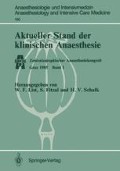Zusammenfassung
Seit Sir Humphrey Davy vor nun beinahe 200 Jahren berichtete, daß die Inhalation von Lachgas schmerzlindernd wirkt und seit den Pioniertagen von Horace Wells Mitte vorigen Jahrhunderts ist Lachgas aus der anästhesiologischen Praxis nicht mehr fortzudenken. Seine analgetische Potenz, geringe Toxizität, Nicht-Explosivität und offenbar geringen kardiodepressiven Eigenschaften haben Lachgas zu einem häufig benutzten Anästhetikum im Operationsalltag gemacht.
Access this chapter
Tax calculation will be finalised at checkout
Purchases are for personal use only
Preview
Unable to display preview. Download preview PDF.
Literatur
Rudolph AM, Heymann MA (1967) The circulation of the fetus in utero. Circ Res 21:163
Hornbein TF, Martin WE, Bonica JJ, Freund FG, Parmentier P (1969) Nitrous oxide effects on the circulatory and ventilatory response to halothane. Anesthesiology 31:250
Cullen DJ, Eger EI II (1974) Cardiovascular effects of carbon dioxide in man. Anesthesiology 41:345
Daly JW, Bondurant S (1962) Effects of oxygen breating on the heart rate, blood pressure and cardiac index of normal men — resting, with reactive hyperemia and after atropine. L Clin Invest 41:126
Fukunaga AF, Epstein RM (1973) Sympathetic excitation during nitrous oxidehalothane anesthesia in the cat. Anesthesiology 39: 23
Thomson I A, Hughes RL, Fitch W, Campbell D (1982) Effects of N20 on liver hemodynamics and oxygen consumption in the greyhound. Anaesthesia 37:548
Andreen M, Irestedt L, Zetterström B (1977) The different responses of the hepatic arterial bed to hypovolaemia and to helothane anaesthesia. Acta Anaesthesiol Scand 21:457
Wollman H, Alexander SC, Cohen PJ, Smith TC, Chase PE, van der Molen RA (1965) Cerebral circulation during general anesthesia and hyperventilation in man: thiopental induction to nitrous oxide and d-tubocurarine. Anesthesiology 26:329
Jobes DR, Kennel EM, Bush GL, Mull TD, Lecky JH, Behar MG, Wollman H (1977) Cerebral blood flow and metabolism during morphine-nitrous oxide anesthesia in man. Anesthesiology 47:16
Sakabe T, Kuramoto T, Kumagae S, Takeshita H (1976) Cerebral responses to the addition of N20 to halothane in man. Br J Anaesth 48:957
Henriksen HT, Jörgensen PB (1973) The effect of nitrous oxide on intracranial pressure in patients with intracranial disorders. Br J Anaesth 45:486
Phirman JR, Shapiro HM (1977) Modification of nitrous oxide-induced intracranial hypertension by prior induction of anesthesia. Anesthesiology 46:150
Editor information
Editors and Affiliations
Rights and permissions
Copyright information
© 1986 Springer-Verlag Berlin Heidelberg
About this paper
Cite this paper
Seyde, W.C., Ellis, J., Longnecker, D.E. (1986). Die zusätzliche Gabe von Lachgas während einer Halothannarkose vermindert die Durchblutung von Nieren, Leber und Dünndarm und steigert die Gehirndurchblutung. In: List, W.F., Schalk, H.V., Fitzal, S. (eds) Aktueller Stand der klinischen Anaesthesie. Anaesthesiologie und Intensivmedizin / Anaesthesiology and Intensive Care Medicine, vol 190. Springer, Berlin, Heidelberg. https://doi.org/10.1007/978-3-642-71229-6_4
Download citation
DOI: https://doi.org/10.1007/978-3-642-71229-6_4
Publisher Name: Springer, Berlin, Heidelberg
Print ISBN: 978-3-540-16573-6
Online ISBN: 978-3-642-71229-6
eBook Packages: Springer Book Archive

